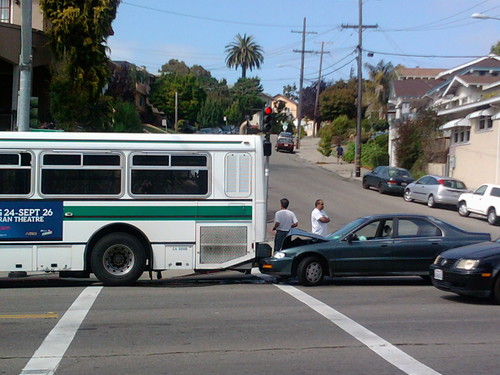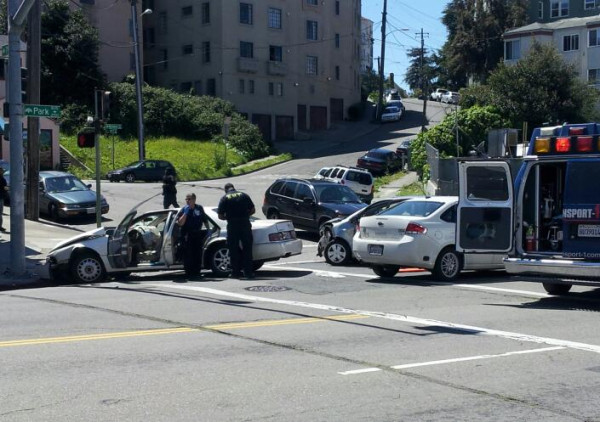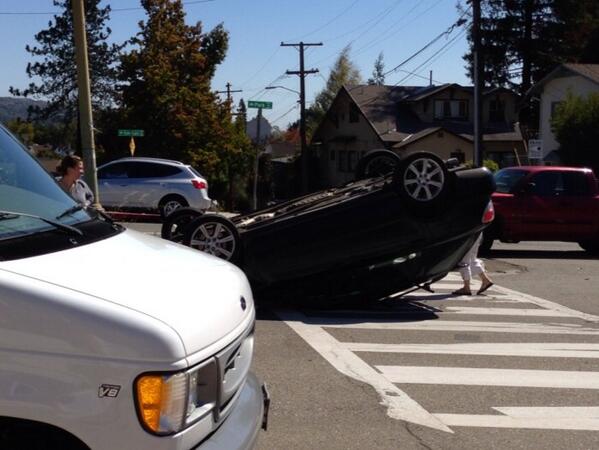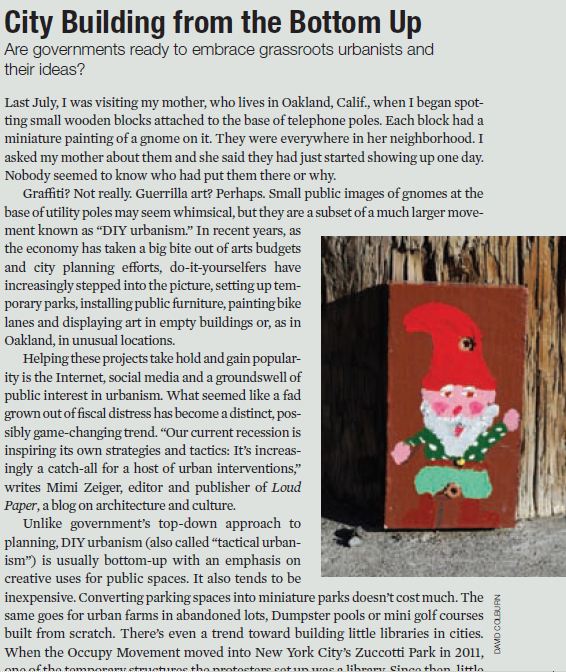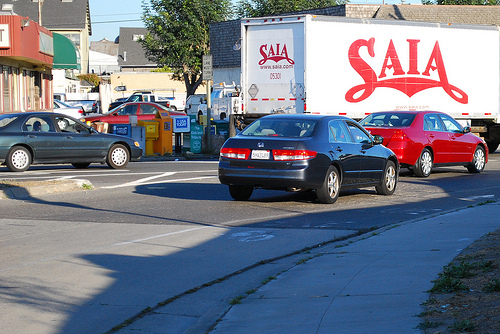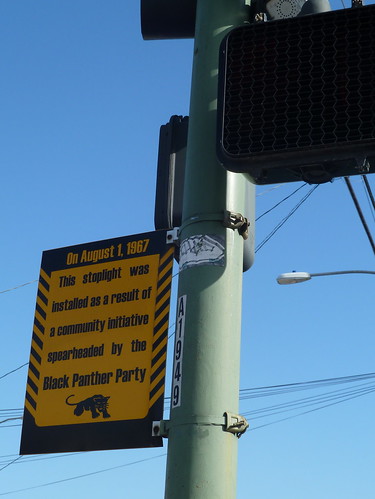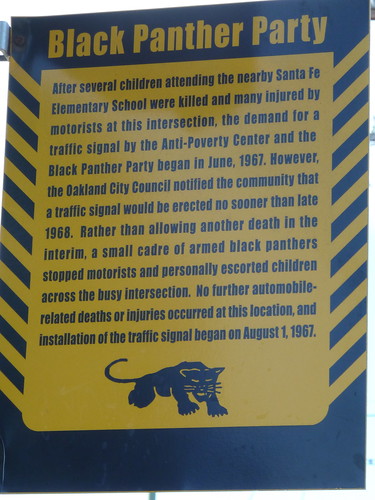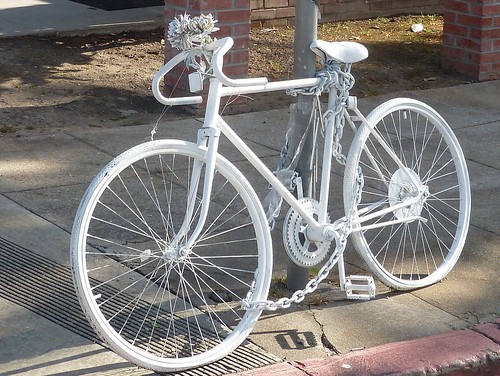The following is a short history of Oakland’s Miller Avenue Library written in 1996, excerpted from the registration form for the National Register of Historic Places (available in PDF form at the National Park Service website). The vacant, city-owned building is currently the site of the Biblioteca Popular Victor Martinez, or the People’s Library, where activists and neighborhood residents are operating an open-air volunteer library and community garden.
Narrative Statement of Significance
The Oakland Free Library 23rd Avenue Branch (later Ina Coolbrith Branch, now commonly called Miller Avenue Library), a Carnegie Library, meets the requirements for National Register nomination as set forth in the Multiple Property nomination entitled “Carnegie Library development in California and the Architecture it Produced, 1899-1921.” It was one of four architecturally similar but varied branches built under a 1914 grant to the city of Oakland, in four different North and East Oakland neighborhoods, designed by Oakland architects of statewide prominence. It served as a library from its construction to the late 1970s. Physically it is slightly but not greatly changed inside and out.
Oakland pioneered branch libraries in California, opening branch reading rooms as early as 1878 and continuing to emphasize neighborhood branches as the city expanded. The 23rd Avenue branch traces its history to a reading room established in 1890 in what was then the easternmost part of Oakland, under the auspices of the Library Board with assistance from the 23rd Avenue Improvement Club. It occupied a succession of rented locations on the busy 23rd Avenue commercial strip (back to back with the present location). The present building was the second of the four libraries constructed with the 1914 Carnegie grant obtained by City Librarian Charles Greene for new branch library buildings. Greene’s project was suited to the Carnegie philosophy at the time; since 1899 when Oakland’s downtown Main Library had been funded, Carnegie’s focus had shifted to small towns and, in metropolitan areas, branches, to bring books closer to the people.
Oakland applied for and received a grant of $140,000 for four new libraries. The $35,000 per branch was apparently a typical amount for a medium-large city. The four new libraries were to replace four of Oakland’s ten existing branches. The sites ultimately selected were Golden Gate and Alden in North Oakland, and Melrose and 23rd Avenue in East Oakland. Oakland’s match was to provide sites for the buildings, and 10% of the grant amount per year to maintain the buildings and their operations.
Site selection for the 23rd Avenue branch seems to have been the most problematic of the four. The library board originally looked for a site to replace the existing East Oakland branch at 9th Avenue and East 14th Street in the old, fully built up Clinton neighborhood. This stirred protests against a location in the East 14th Street commercial area, and demands that the branch be located in one of the newer lakeshore residential areas farther north. After almost two years, the board gave up on finding an acceptable site in the service area of the old East Oakland branch, and accepted the donation of a site to replace the next branch south, 23rd Avenue, in what is now called the San Antonio neighborhood.
The site was donated by Henry Root, also co-donor with County Supervisor J.R. Talcott of the Melrose Branch site. Root was a railroad man and large local landowner with an interest in enhancing the amenities of the district. The donation was conditioned on the city’s extending a street in front of the library, thereby assisting Root in subdividing a very large block. The new street was originally called Foothill Boulevard, an extension of the scenic boulevard developed by Talcott through his Fruitvale neighborhood holdings parallel to East 14th Street. In August 1925 the street name was changed to Miller Avenue: reportedly “for a veteran of World War I,” notwithstanding the coincidence with the name of Grant Miller, county coroner whose mortuary business also fronted on the new street.
Building permit #46090 was issued for the 23rd Avenue branch on July 20, 1917, for a brick and concrete library building, with an estimated construction cost of $31,000. The plans credit John J. Donovan, architect for the City of Oakland, and C.W. Dickey, associate architect. Contractor was Nielsen & Bertelsen. Reportedly escalating construction costs resulted in some of the funds for the Alden and Golden Gate branches, not yet begun, being diverted to the elaborate Spanish Colonial 23rd Avenue branch.
The 23rd Avenue, Golden Gate, and Alden branches were all designed by Charles W. Dickey and John J. Donovan; the first branch constructed, Melrose, was by reinforced concrete expert William Weeks. The three Dickey and Donovan libraries had virtually identical plans and programs, and different period costumes: Spanish Colonial for 23rd Avenue, and a more austere Tudor for Alden and Georgian for Golden Gate. The Oakland Examiner of July 1, 1917, gave an excellent collective description of the three:
C.W. Dickey and John J. Donovan are the architects for three libraries which remain to be built. The branch to be next constructed [23rd Avenue] will be of Spanish architecture with warm colored stucco walls over brick and a variegated Cordova roof. The Alden branch library… will be of modern English design with walls of dark red brick. The Golden Gate branch library… will be of Colonial design with red brick walls with white trimmings. While the external appearance of the three buildings will be totally different, they will have the same interior requirements and fittings.
Each library will be two stories in height, the main entrance being halfway between the two stories, with broad stairs leading up into the central delivery room, and other stairs leading to the ground floor. The delivery desk is to be so placed that the librarian in charge will have complete command of the two reading rooms flanking the delivery room and of the main entrance.
The reading rooms will each be about thirty-two by forty-one feet, lined with book shelves capable of accommodating 15,000 volumes, besides magazines and newspapers. The rooms will be lighted from three sides in the daytime and by semi-direct electric fixtures at night. The openings from the reading rooms to the delivery room will be so large that the three rooms will architecturally count as one. Back of the delivery room will be the librarian’s private office and the book bindery with a private staircase leading to the lower floor.
On the ground floor will be located an assembly room about thirty by forty feet, capable of seating about 250 persons and fitted with a stage and electric connections for a moving picture machine. On this floor there will also be a study room sixteen by thirty-one feet, a staff room with a kitchenette, a furnace room, men’s and women’s toilets and a large shipping and receiving room with a fumigating closet and book lift to take books to the second floor.
Each of the buildings will cost $35,000: the construction, finish, heating and ventilation will be modern and first class in every respect.
Architects Charles Dickey and John Donovan were associated on three Oakland Carnegie libraries in 1917, and designed Oakland schools in the 1910s and 20s. Charles Dickey (1871-1942) was born in Alameda and studied architecture at MIT. He practiced in Oakland from about 1903 to 1924 and thereafter in Honolulu, where he is considered to have created a distinctive Hawaiian style of architecture. His numerous major Oakland works include the Claremont Hotel (1907), the 15-story Oakland Bank of Savings at 1200 Broadway (1907; one of Oakland’s first skyscrapers), Kahn’s Department Store (1913), and University High School (1922). MIT-trained John Donovan (1877-1949) came west in 1911 as supervising architect for Oakland City Hall, representing the New York firm of Palmer & Hornbostel. He stayed to become Oakland City Architect, supervising architect for the Oakland Auditorium and Oakland’s $2.6 million school construction program of 1911-19, an authority on school design, and an architectural consultant for the Bay Bridge.
The new 23rd Avenue Branch building was dedicated on March 14, 1918, with the Garfield Civic Association arranging the program. (They also sponsored a “Book Drive Entertainment” a month later to benefit the new library.) Speakers at the dedication included Charles Greene on “The Library as a Municipal Asset,” and John Miller, superintendent of the California Cotton Mills, on “The Relation of the Library to Industrial Life.” The California Cotton Mills had been a major local employer since 1884, especially in the largely Portuguese Jingletown neighborhood “below the tracks.” In the years after World War I the Oakland schools and libraries were very conscious of their mission of “Americanization” to Oakland’s large foreign-born population of many nationalities. The June 30, 1929, annual report of the 23rd Avenue Branch gives a vivid picture of the neighborhood:
The development of the Twenty-third Avenue district this year has been along the line of more apartment houses, stores, restaurants, and factories…This has always been a factory district, and across the S.P. tracks lies the Estuary with its many facilities of rail and water, giving rise to many industrial plants and other institutions. The California Cotton Mills, employing many Portuguese and other foreigners, ranges in its demand upon us from Portuguese fiction and Americanization literature to technical philosophy for the Vice-president’s son…
The ten largest industrial plants now in our section are: International Harvester Co. of America; Bent Concrete Pipe Co.; Atlas Imperial Engine Co.; John Wood Mfg. Co.; California Cotton Mills; Ventura Oil Co.; Montgomery Ward; Contra Costa Laundry (splendid new plant); Barrow Corporation; and Union Diesel Engine Co. …
These, with the Coast Guard on Government Island, send in some call for our scientific books. The wives of the officers of this prohibition Guard live in apartments here and read the usual apartment-house fiction. …
Our surrounding population may now have become over one half American, though the many foreign races are most evident: Portuguese, Spanish, Italian, French, German, Norwegian, Swedish, Czecho-Slovakian, Polish, Greek, Chinese, Japanese, and Negro…
To make them happy, so that they will love America, long to become Americans, and read American books, is our task…. Mrs. Eleanor Smith, Americanization teacher of the Garfield School has been a great help to us in bringing about a larger purchase of foreign books and their deposit in the branches, where our timid patrons can see and choose their own books…. This also helps the second generation to respect and obey their parents, and to become richer by the possession of two languages and literatures.
In 1966, near the end of the building’s service as a library, the city acknowledged the confusion of the 23rd Avenue Branch not being on 23rd Avenue, and renamed it Ina Coolbrith Branch, for Oakland’s first City Librarian. By 1973 it had become the Latin American Branch, and last appears in directories as a library in 1976, though building permits from 1980 (for electrical work and fire repairs) still refer to it as Miller Library. It has been used as a nursery school and for other school district uses, as city council district offices, and by Volunteers of America – the current occupants – for social services and job training. It is an Oakland City Landmark, designated November 4, 1980, in a group designation of the city’s four Carnegie branch libraries.

